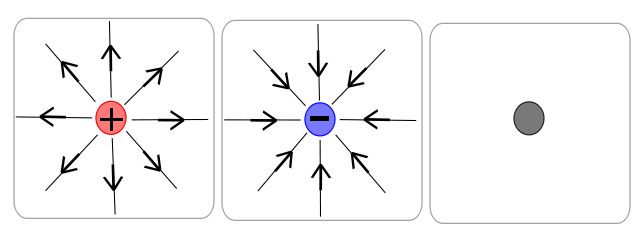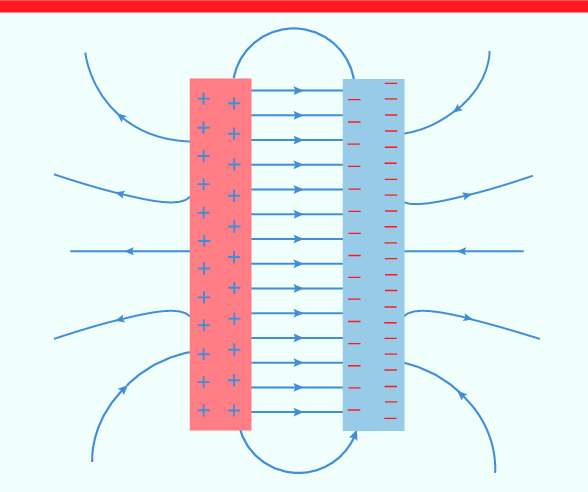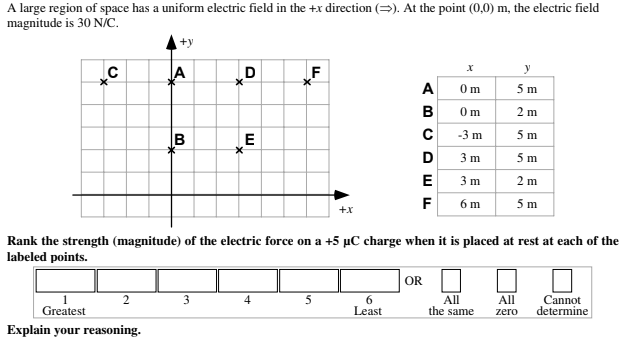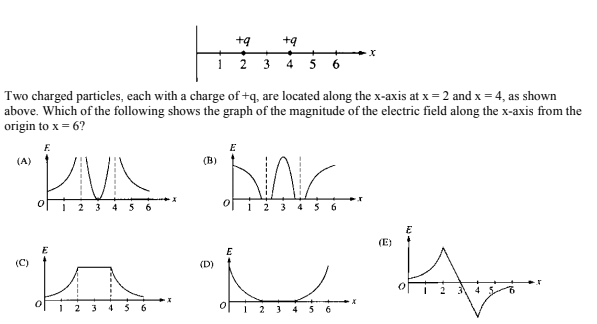K
Krish Gupta
Daniella Garcia-Loos
AP Physics 2 🧲
61 resourcesSee Units
Electric Charges and Fields
Electric Fields
An electric field is a vector field that describes the force experienced by a charged particle at a given point in space due to the presence of other charged particles.
Here are some key points about electric fields:
- Electric fields are created by electric charges, which can be either positive or negative. Positive charges create an electric field that points away from the charge, while negative charges create an electric field that points towards the charge.
- The strength of an electric field is determined by the amount of charge producing the field and the distance from the charge. The electric field is stronger the closer you are to the charge and weaker the further away you are.
- Electric fields can be represented graphically using lines of force, which are lines that show the direction that a positive test charge would be pushed if placed in the field. The density of the lines indicates the strength of the field.
- Electric fields can be used to understand and analyze how electric forces and charges interact with each other.
- Electric fields are an important concept in electromagnetism and are used in a variety of applications, including electricity generation, motors and generators, and electronic devices.
Every charged object has an electric field surrounding it, similar to how every object with mass has its own gravitational field. The more charge (or mass) there is, the stronger the field is. The only difference is that, while a gravitational field must be attractive, an electric field can be either attractive or repulsive. By convention, we use the direction that a positive test charge will move to draw our electric fields.
Rules for Drawing:
- Field lines are vectors and must be drawn with arrows.
- Lines go away from a positive charge and towards a negative charge.
- The strength of the field can be visually represented by the density of the field lines. Therefore field, lines must never touch or cross. This would represent an infinitely strong field.
Simple Fields
- Point Charges

Image from wikimedia.org
- Two Point Charges
Image from Ck12.org
- Two Parallel Plates
- Notice how the field is the same everywhere between the plates.

Image from researchgate.net
Try using the PhET simulation to create your own fields and notice the how the field strength changes as a function of charge and distance.
Electric Field Strength
We've seen visually what electric fields look like. Now it's time to mathematically describe them.
Electric field strength is a measure of the electric force experienced by a charged particle at a given point in space due to the presence of other charged particles.
Here are some key points about electric field strength:
- Electric field strength is represented by the symbol "E" and is measured in units of volts per meter (V/m).
- The electric field strength at a given point is determined by the amount of charge producing the field and the distance from the charge. The electric field is stronger the closer you are to the charge and weaker the further away you are.
- Electric field strength can be calculated using the formula E = F/q, where E is the electric field strength, F is the electric force experienced by the charged particle, and q is the charge of the particle.
- Electric field strength is an important concept in electromagnetism and is used to understand and analyze how electric forces and charges interact with each other.
- The electric field strength at a point can be determined by measuring the force experienced by a charged particle placed at that point. The electric field strength can also be calculated from the distribution of charges producing the field.
The basic idea is to place a test charge at various locations in the field, measure the electrostatic force at that location, then calculate the field strength. The equation off of your reference tables for electric field strength is:
where Fe is the electrostatic force found by using Coulomb's Law, and q is the charge on the test charge used to measure the field.
We can also rearrange the equation to determine EE in terms of the charge on the point charge Q
Practice Questions
1.

Image created by author
Answer:
- The force at each location is the same. The field is uniform so E is constant everywhere and q is the same for each case. Fe=Eq, so the force must be the same.
2.

Image from apclassroom.collegeboard.org
At which of the labeled points on the x-axis is the electric field zero?
Answer:
- Point A must have an electric field strength of 0. The point must be closer to the smaller charge (Q) than the larger charge (-4Q), so it can't be D or E. It must also be where the force vectors between the test charge point in the opposite direction so that the net force is 0. Therefore, it can't be point C either. Since the negative charge (-4Q) is 4x greater than the positive charge, the point must be 2x as far from the -4Q charge as it is from the Q charge.
That only leaves A as the answer.
3.

Image from apclassroom.collegeboard.org
- Graph A is correct. At x = 2 and x = 4, the distance from the charges is 0, so the field strength must trend towards infinity. At x = 3, the repulsion from the 2 charges cancels out so the field must be 0 there.
Browse Study Guides By Unit
💧Unit 1 – Fluids
🔥Unit 2 – Thermodynamics
⚡️Unit 3 – Electric Force, Field, & Potential
💡Unit 4 – Electric Circuits
🧲Unit 5 – Magnetism & Electromagnetic Induction
🔍Unit 6 – Geometric & Physical Optics
⚛️Unit 7 – Quantum, Atomic, & Nuclear Physics
📆Big Reviews: Finals & Exam Prep
📚Study Tools

Fiveable
Resources
© 2025 Fiveable Inc. All rights reserved.